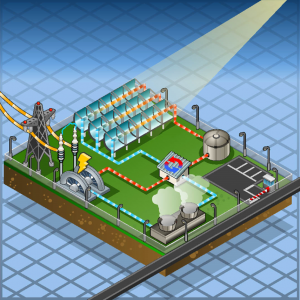Technology
Solar thermal energy, unlike other renewables, can generate electricity when the natural resource is not available, as it is able to connect to thermal storage systems. Energy in the form of heat is accumulated in tanks, using molten nitrate mixtures, or "molten salts", for storage. The two main technologies are:
Parabolic Trough Technology
These plants are made up of a field of parabolic-shaped heliostats which concentrate solar radiation along the focal line of each mirror, where the collectors are positioned. These collectors contain a receiving fluid; in most technologies, a thermal oil that absorb the heat. The mirrors have a tracking system that enables them to change their position and follow the solar cycle.
Two fluids are used, one to collect the heat, "thermal oil", and another one to store it, "molten salts". The operating temperature range is between 250ºC and 390ºC, the maximum temperature possible limited by the decomposition of oil, which restricts the efficiency of the Rankine cycle.
Central Tower Technology
In solar tower technology the radiation reaching the heliostats is focused on one point in the tower. In the receiver, the "molten salts" act simultaneously as a fluid for collection and storage. The saline mixture heat is directly released to generate steam or is moved into a tank where it is stored. The operating temperature rangefor this technology is 250ºC to 500ºC
To date, both solar thermal technologies have low electricity generation yields given the limited operating temperature range of the fluids currently being used.
Current "molten salts" are highly corrosive, leading to production downtime and very high operation and maintenance costs. Electricity generation costs are higher than for those using fossil fuel generation technologies.
Our objective as a company is to develop new "molten salts" that eliminate the safety issues by replacing the oil, increasing the operating temperature range, making them less corrosive, extending the plant's useful life and maximizing electricity generation.
In short, to reduce the costs of solar thermal electricity generation to make it more competitive."






